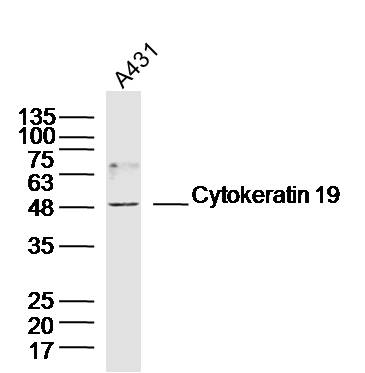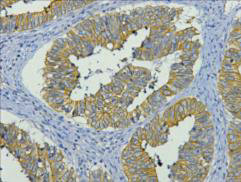
Immunohistochemical staining of formalin fixed and paraffin embedded human breast cancer tissue section using anti-CK-19 rabbit monoclonal antibody (Clone RM364) at a 1:1000 dilution.
anti-Cytokeratin-19 (human), Rabbit Monoclonal (RM364)
REV-31-1249-00
ApplicationsWestern Blot, ImmunoHistoChemistry
Product group Antibodies
ReactivityHuman
TargetKRT19
Overview
- SupplierRevMAb Biosciences
- Product Nameanti-Cytokeratin-19 (human), Rabbit Monoclonal (RM364)
- Delivery Days Customer10
- ApplicationsWestern Blot, ImmunoHistoChemistry
- CertificationResearch Use Only
- ClonalityMonoclonal
- Clone IDRM364
- Gene ID3880
- Target nameKRT19
- Target descriptionkeratin 19
- Target synonymsCK19, K19, K1CS, keratin, type I cytoskeletal 19, 40-kDa keratin intermediate filament, CK-19, cytokeratin 19, keratin 19, type I, keratin, type I, 40-kd
- HostRabbit
- IsotypeIgG
- Protein IDP08727
- Protein NameKeratin, type I cytoskeletal 19
- Scientific DescriptionCytokeratins are keratin proteins found in the intracytoplasmic cytoskeleton of epithelial tissue (at least 20 different polypeptides). They are an important component of intermediate filaments, which help cells resist mechanical stress. Expression of these cytokeratins within epithelial cells is largely specific to particular organs or tissues. The subsets of cytokeratins which an epithelial cell expresses depends mainly on the type of epithelium, the moment in the course of terminal differentiation and the stage of development. Thus a specific cytokeratin expression profile allows the identification of epithelial cells. Furthermore, this applies also to the malignant counterparts of the epithelia, (carcinomas). Cytokeratin subtype expression patterns are used to an increasing extent in the distinction of different types of epithelial malignancies. The cytokeratin antibodies are not only of assistance in the differential diagnosis of tumors using immunohistochemistry on tissue sections, but are also a useful tool in cytopathology and flow cytometric assays. Cytokeratin-19 is a type I cytokeratin. The type I cytokeratins consist of acidic proteins which are arranged in pairs of heterotypic cytokeratin chains. Unlike its related family members, this smallest known acidic cytokeratin is not paired with a basic cytokeratin in epithelial cells. It is specifically found in the periderm, the transiently superficial layer that envelops the developing epidermis. Cytokeratin-19 is often used together with cytokeratin-8 and cytokeratin-18 to differentiate cells of epithelial origin from hematopoietic cells in tests that enumerate circulating tumor cells in blood. - Recombinant Antibody. This antibody reacts human CK-19 (Cytokeratin-19). Applications: WB, IHC. Source: Rabbit. Liquid. 50% Glycerol/PBS with 1% BSA and 0.09% sodium azide. Cytokeratins are keratin proteins found in the intracytoplasmic cytoskeleton of epithelial tissue (at least 20 different polypeptides). They are an important component of intermediate filaments, which help cells resist mechanical stress. Expression of these cytokeratins within epithelial cells is largely specific to particular organs or tissues. The subsets of cytokeratins which an epithelial cell expresses depends mainly on the type of epithelium, the moment in the course of terminal differentiation and the stage of development. Thus a specific cytokeratin expression profile allows the identification of epithelial cells. Furthermore, this applies also to the malignant counterparts of the epithelia, (carcinomas). Cytokeratin subtype expression patterns are used to an increasing extent in the distinction of different types of epithelial malignancies. The cytokeratin antibodies are not only of assistance in the differential diagnosis of tumors using immunohistochemistry on tissue sections, but are also a useful tool in cytopathology and flow cytometric assays. Cytokeratin-19 is a type I cytokeratin. The type I cytokeratins consist of acidic proteins which are arranged in pairs of heterotypic cytokeratin chains. Unlike its related family members, this smallest known acidic cytokeratin is not paired with a basic cytokeratin in epithelial cells. It is specifically found in the periderm, the transiently superficial layer that envelops the developing epidermis. Cytokeratin-19 is often used together with cytokeratin-8 and cytokeratin-18 to differentiate cells of epithelial origin from hematopoietic cells in tests that enumerate circulating tumor cells in blood.
- ReactivityHuman
- Storage Instruction-20°C
- UNSPSC12352203






